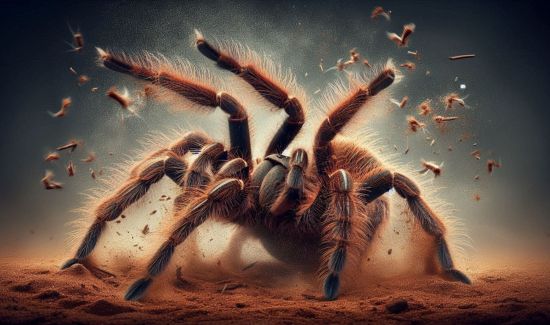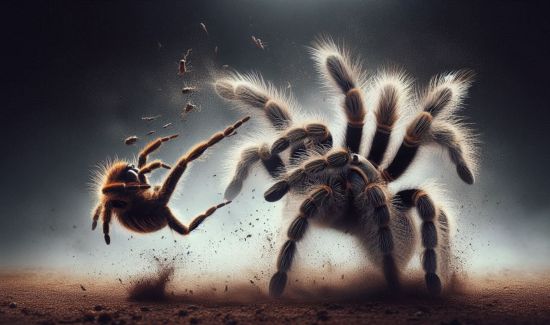Introduction
Table of Contents
Tarantulas are fascinating creatures that have captivated both scientists and pet enthusiasts. One of the unique features of tarantulas is their urticating hairs. These tiny, barbed hairs are used by tarantulas as a defense mechanism against predators. While these hairs might not be well-known to everyone, understanding them is essential, especially if you live in areas where tarantulas are common or if you’re a tarantula owner.
In this article, we’ll dive deep into the different Tarantula urticating hair types that tarantulas possess, how they use them, and why they’re so important.
What Are Tarantula Urticating Hairs?
Urticating hairs are specialized bristles that certain tarantula species use for defense. When threatened, a tarantula may rub its hind legs against its abdomen, releasing these hairs into the air. The hairs can cause irritation to the skin, eyes, and mucous membranes of potential predators or humans. There are different types of urticating hairs, each with unique structures and effects.
Tarantula Urticating Hair Types
There are six main types of Tarantula urticating hairs, classified based on their shape, size, and function. These types are mainly found in New World tarantulas, which are native to North, Central, and South America.
Type I Urticating Hairs
Type I hairs are long and slender, resembling tiny needles. They are commonly found in species like the Brazilian salmon pink bird-eating tarantula. These hairs are used primarily against larger predators like mammals.
- Appearance: Long, thin, needle-like
- Function: Defense against larger predators
Type II Urticating Hairs
Type II hairs are shorter and thicker than Type I. They are less common and are found in species like the Costa Rican zebra tarantula. These hairs are less effective against larger predators but can still cause irritation.
- Appearance: Short, thick
- Function: Mild defense, primarily irritation
Type III Urticating Hairs
Type III hairs are the most common type and are found in many tarantula species, including the Chilean rose hair tarantula. These hairs are barbed and can easily become embedded in the skin, causing intense itching and irritation.
- Appearance: Barbed, medium length
- Function: Irritation and defense against small to medium-sized predators
Type IV Urticating Hairs
Type IV hairs are unique to the Theraphosa blondi, also known as the Goliath birdeater. These hairs are large and have a spear-like shape, making them particularly effective at deterring predators.
- Appearance: Large, spear-like
- Function: Strong defense, can cause significant discomfort
Type V Urticating Hairs
Type V hairs are found in the Megaphobema robustum species. These hairs are more specialized for close-range defense, making them effective against small animals that come into direct contact with the tarantula.
- Appearance: Short, thick, blunt
- Function: Close-range defense
Type VI Urticating Hairs
Type VI hairs are the least understood and are found in some Avicularia species. These hairs are very fine and can become airborne easily, making them more effective against flying insects and other small predators.
- Appearance: Fine, easily airborne
- Function: Defense against small, flying predators
How Tarantulas Use Urticating Hairs
Tarantulas use their urticating hairs in various ways, depending on the type of hair and the threat they face. The most common method is to kick the hairs off their abdomen with their hind legs, creating a cloud of irritating hairs that can deter predators. Some species, like the Goliath birdeater, may use their hairs more aggressively by directly rubbing them against their attacker.

Tarantula Defense Mechanism
When threatened, a tarantula will often rear up on its hind legs, displaying its fangs and raising its front legs. If the predator doesn’t back off, the tarantula will release its urticating hairs as a second line of defense. This behavior is particularly common in New World tarantulas.
Why Are Urticating Hairs Important?
Urticating hairs are a critical defense mechanism for tarantulas. Without these hairs, they would be more vulnerable to predators like birds, mammals, and even other spiders. For tarantula owners, understanding these hairs is important because handling certain species can result in skin irritation or more severe reactions.
How Tarantula Urticating Hairs Affect Humans
While urticating hairs are primarily a defense against predators, they can also affect humans. When these hairs come into contact with the skin, they can cause itching, redness, and irritation. In some cases, if the hairs enter the eyes or respiratory system, they can cause more serious problems, such as difficulty breathing or severe eye irritation.
Dealing with Urticating Hairs
If you come into contact with urticating hairs, it’s important to wash the affected area with soap and water as soon as possible. Avoid scratching, as this can cause the hairs to penetrate deeper into the skin. If the hairs get into your eyes, seek medical attention immediately.
Tarantula Species and Their Urticating Hairs
Different tarantula species have different types of urticating hairs. Here’s a table summarizing the types of hairs found in various species:
| Tarantula Species | Type of Urticating Hairs |
|---|---|
| Brazilian salmon pink bird-eating | Type I |
| Costa Rican zebra tarantula | Type II |
| Chilean rose hair tarantula | Type III |
| Goliath birdeater | Type IV |
| Megaphobema robustum | Type V |
| Avicularia species | Type VI |
Conclusion
Urticating hairs are an incredible adaptation that helps tarantulas survive in the wild. Whether you’re a tarantula owner or simply interested in these amazing creatures, understanding the different types of urticating hairs can give you a deeper appreciation for how tarantulas protect themselves. Always handle tarantulas with care, and if you’re in an area where tarantulas are common, be mindful of these tiny, yet powerful, defense mechanisms.
FAQs About Tarantula Urticating Hairs Types
- What are urticating hairs? Urticating hairs are tiny, barbed bristles that tarantulas use for defense against predators.
- Can urticating hairs harm humans? Yes, urticating hairs can cause itching, irritation, and even more serious issues if they enter the eyes or respiratory system.
- Which tarantula species have urticating hairs? Many New World tarantulas, such as the Chilean rose hair tarantula and Goliath birdeater, have urticating hairs.
- How do tarantulas use urticating hairs? Tarantulas kick their urticating hairs off their abdomen to create an irritating cloud that deters predators.
- What should I do if I come into contact with urticating hairs? Wash the affected area with soap and water, and avoid scratching. Seek medical attention if the hairs get into your eyes or respiratory system.

